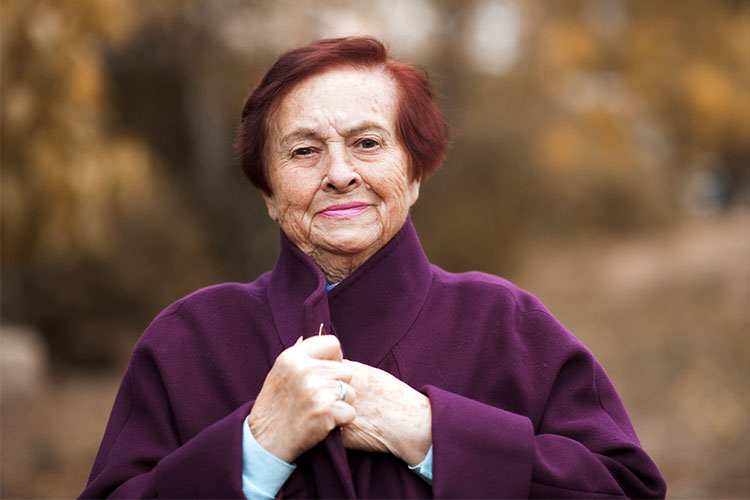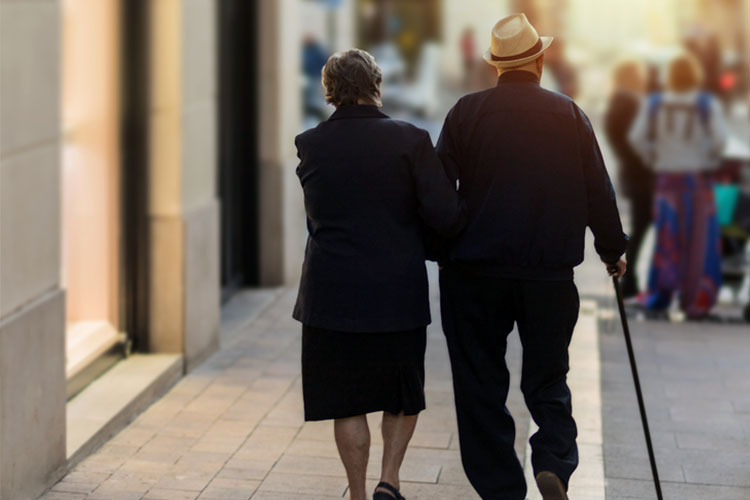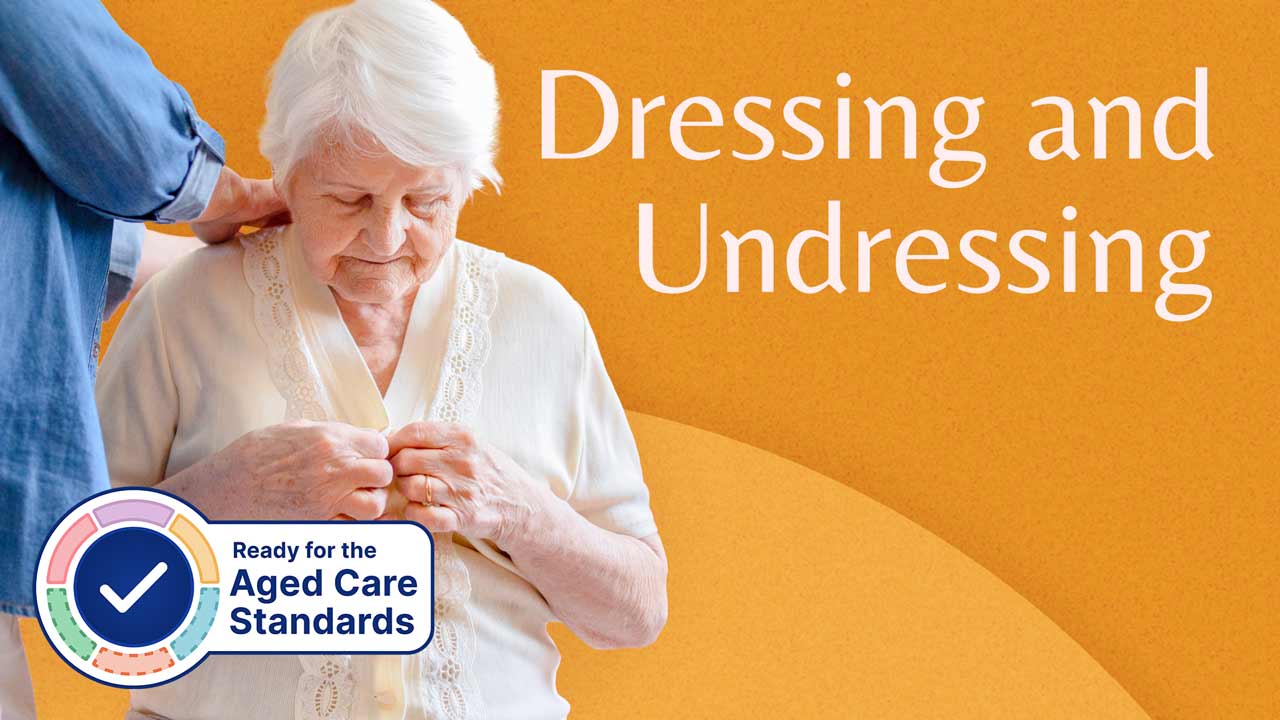How we choose to dress and groom can say a lot about who we are and how we want others to see us.
When a person with dementia begins to lose aspects of themself due to a loss of memory and cognitive functions, they may express a strong desire to hold onto their identity where they can. You are in a unique position to help them achieve this.
The seemingly small task of dressing can prove to be very distressing for people with dementia, for a range of reasons. Grooming and getting dressed can be confusing and time-consuming for residents and care workers as many separate steps are involved.
Helping a person with dementia dress or undress can be challenging. Therefore, communication is crucial and care must be individualised - essentially, it’s best to avoid a one-size-fits-all approach.
This article will provide useful tips for dressing, undressing and grooming a person with dementia in a way that allows you to provide dignified, effective care.
Take the time to find out what a resident’s dressing habits used to be so that you can help them to continue to dress how they would like to (Health.vic 2016).

Dressing and Undressing for People Who Have Dementia Under the Strengthened Aged Care Quality Standards
Standard 5: Clinical Care - Outcome 5.6: Cognitive Impairment under the strengthened Aged Care Quality Standards (Action 5.6.1) requires aged care providers to recognise and address the complex clinical care needs of people with dementia by providing increased care where needed. They should also monitor the changing daily care needs of people with dementia, including those related to personal hygiene (ACQSC 2024).
Reasons Why Someone May Have Problems Dressing or Undressing
There are a few common reasons as to why a person with dementia may have difficulty getting dressed. They fall under the following:
- Physical or medical issues:
- Dementia affects fine and gross motor skills. The person may also have impaired vision
- Depression is common in dementia, and this may lead to the person losing interest in dressing and grooming
- Forgetfulness:
- A person who has dementia may forget how to dress, forget to change their clothes, or suddenly forget they are getting dressed
- Environmental issues:
- Room elements such as lighting, noise, clutter and other people can upset a person with dementia
- A person with dementia will be particularly sensitive to temperature and/or their senses may be impaired
- Privacy concerns:
- Loss of independence will be particularly apparent to a person with dementia who now needs help dressing. They may resist help with dressing if adequate privacy is not provided
- Decision-making problems:
- Making seemingly small decisions might be difficult for someone with dementia. It’s important for the person to make their own decisions even if it takes more time. Make the process as easy as possible for them by organising their clothes beforehand
- Impaired senses:
- People with dementia may have a skewed sense of hot and cold. They might, for example, put on several layers of clothing, despite hot weather.
(Dementia Australia 2024; Alzheimer’s Association 2024)
Simple Steps to Help a Person with Dementia Dress and Undress
Environment
- Respect the person’s privacy by keeping doors and curtains closed
- Keep the room warm, or at the temperature requested by the person
- Allocate sufficient time to the task
- Ensure lighting is adequate
- Avoid having too many clothing choices available, as this can be overwhelming. Remove distractions such as out-of-season clothes from sight.
Your Actions
- Encourage the person to dress themself as much as they are able to, so as to promote independence
- Place clothes on the bed in the order they are to be put on
- Make careful and gentle movements
- Plan the process beforehand and provide clear instructions
- Reassure the person during the process
- Communicate frequently and effectively - the person may not understand why they are being undressed
- Be flexible
- If possible, arrange for the same staff member to help a person dress and undress and take gender preferences into account
- Remember that being dressed and undressed can be an embarrassing experience, so preserve the person’s modesty as much as possible and be empathetic throughout the process.
Clothing Choices
- Try to dissuade the person from picking clothing with copious buttons, hooks, zippers or buckles
- Identify a person’s activities for the day and provide clothing options accordingly
- Keep in mind that busy and bright colours may be over-stimulating
- Slip-on shoes may be easier than shoes with laces and ties
- Loose-fitting and comfortable clothing is best
- Front-fastening bras might be easier for a person to put on.
(Dementia Australia 2024; Alzheimer’s Association 2024; Health.vic 2016; Alzheimer Society of Canada 2020; HealthNetCafe n.d.)

Grooming
Similarly to forgetting how to dress, a person with dementia may also forget how to groom themself or may need extra help to do so. Tasks that were once simple, such as combing their hair, shaving or trimming their fingernails, may become confusing, or the person may forget what items such as nail clippers or combs are intended for (Alzheimer’s Association 2024).
Simple Steps to Help a Person with Dementia Groom Themself
- Follow and maintain grooming routines
- Buy/use the person’s favourite toiletries (e.g. perfumes)
- Perform grooming tasks on yourself in tandem with the person
- Use safe and simple grooming tools
- Frequent trips to the hairdressers/barbers might be an old routine and/or enjoyable experience for the person
- Assist the person to shave or make appointments for shaving if they wish to do so. If you help the person shave, ensure you use an electric razor for safety
- Provide opportunities for beauty therapy appointments such as manicures/pedicures, gentle facials and massages if the person would like this
- If the person wears makeup as part of their daily routine, assist them to do so - for example, by applying lipstick for them
- Ensure the person’s nails are kept clean and trimmed.
(Alzheimer’s Association 2024; Family Caregiver Alliance 2012; Homestyle Aged Care 2022)

Conclusion
Take the time to individualise the dressing and grooming process for each person. Respect their right to dignified care and acknowledge how vulnerable their position is.
In letting you dress, undress and groom them, the person is putting enormous trust in your care and professionalism. Your help could significantly increase their self-esteem and independence in an incredibly difficult time of their life.
Test Your Knowledge
Question 1 of 3
True or false: It’s better to have the same care worker dress and undress a person with dementia.
Topics
References
- Aged Care Quality and Safety Commission 2024, Standard 5: Clinical Care, Australian Government, viewed 29 April 2024, https://www.health.gov.au/resources/publications/strengthened-aged-care-quality-standards-august-2025?language=en
- Alzheimer’s Association 2024, Dressing and Grooming, Alzheimer’s Association, viewed 29 April 2024, https://www.alz.org/help-support/caregiving/daily-care/dressing-grooming
- Alzheimer Society of Canada 2020, Dressing, Alzheimer Society of Canada, viewed 29 April 2024, https://alzheimer.ca/en/help-support/im-caring-person-living-dementia/providing-day-day-care/personal-care/dressing
- Dementia Australia 2024, Getting Dressed, Dementia Australia, viewed 26 April 2024, https://www.dementia.org.au/support-and-services/families-and-friends/personal-care/dressing
- Family Caregiver Alliance 2012, Dressing and Grooming (For Dementia), Family Caregiver Alliance, viewed 29 April 2024, https://www.caregiver.org/resource/dressing-and-grooming-dementia/
- HealthNetCafe n.d., General: Assist in Dressing and Undressing, HealthNetCafe, viewed 29 April 2024, http://www.healthnetcafe.com/content/day-to-day_care/general/dressing_and_undressing.html
- Health.vic 2016, Dressing, Victoria State Government, viewed 26 April 2024, https://www.health.vic.gov.au/dementia-friendly-environments/dressing
- Homestyle Aged Care 2022, ‘The Importance of Self Care in the Elderly’, Homestyle Aged Care Blog, 30 March, viewed 29 April 2024, https://homestyleagedcare.com.au/2022/03/the-importance-of-personal-care-for-the-elderly/
- National Institute on Aging 2017, Bathing, Dressing, and Grooming: Alzheimer's Caregiving Tips, U.S. Department of Health & Human Services, viewed 6 September 2022, https://www.nia.nih.gov/health/bathing-dressing-and-grooming-alzheimers-caregiving-tips
Additional Resources
- Standard 5: Clinical Care
- Stronger Standards, Better Aged Care Program | ACQSC
- Dementia Australia
- National Dementia Helpline: 1800 100 500
 New
New 
